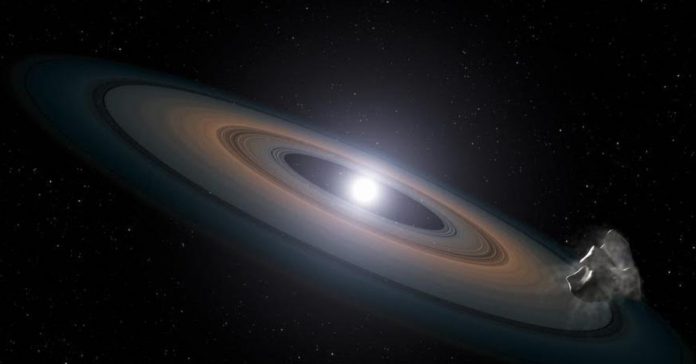A citizen scientist working with NASA has detected an old, cold dying star that may provide a window into the fate of our own solar system billions of years from now.
Melina Thévenot, a citizen scientist from Germany, detected an anomaly while searching through data collected by the European Space Agency’s Gaia spacecraft. At first, she believed it was bad data, but when she looked at the source in the images from NASA’s Wide-field Infrared Survey Explorer (WISE) mission, she decided the data might be valuable and handed it over to the team working on the Backyard Worlds: Planet 9 citizen scientist project.
The leads on that project decided to follow up on the finding, re-positioning the Keck II telescope in Hawaii to take a deeper look. With their new set of eyes focused on the tiny spot in the sky, Keck II confirmed the blip wasn’t bad data — it was the oldest, coldest white dwarf we’ve ever spotted — and it is circled by a peculiar set of dusty rings. The discovery appears Tuesday in The Astrophysical Journal Letters.
“This white dwarf is so old that whatever process is feeding material into its rings must operate on billion-year timescales,” said John Debes, an astronomer and lead author on the study. “This star is really challenging our assumptions of how planetary systems evolve.”
Dubbed J0207 (or LSPM J0207+3331 for the purists), the newly discovered dead star is about the size of the Earth and located around 145 light-years from our home planet. The team believes the dead star has two disks of dusty material, the first known white dwarf to host such a weird phenomenon.
Generally, dusty disks form around these bodies when asteroids or comets are flung into the gravitational pull of a the star. As they approach, the dead star’s gravity begins to tear them apart, breaking them up into pieces that constantly orbit the body. Weirdly, white dwarfs this old generally don’t maintain their dusty disks — all the material slowly falls into the star. That’s puzzled researchers, but follow-up missions may resolve the conundrum.
“What makes this new white dwarf so interesting is that it’s much older than the typical dusty white dwarf,” said Debes. “That is hard to explain with our current models of how asteroids get kicked into inner white dwarf systems, but somehow Nature knows how to do it.”
Intriguingly, the fate of this planetary system may foreshadow what’s to come for the Earth. Eventually, our sun will expand into a “red giant,” swallowing Mercury and Venus (maybe even Earth) whole like The Blob rolling across small-town America. That event would tidy up the inner solar system like a cosmic Marie Kondo, and then see the star collapse into a white dwarf, its gravity dissipate and the planets at the edge of the system drift away.
NASA and collaborating science and educational institutions launched Backyard Worlds: Planet 9 in February 2017 as a citizen scientist project that uses data from WISE to search for the supposed planet hiding at the edge of our solar system. Over 150,000 participants eyeball thousands of images generated by WISE to look for any anomalies that might pop up.
The project has already reaped many rewards, with a brown dwarf, a type of “failed star,” discovered only six days after the project began and over a thousand similar objects discovered since.













